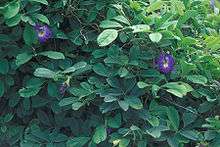Clitoria ternatea
| Clitoria ternatea | |
|---|---|
 | |
| Clitoria ternatea vine | |
| Scientific classification | |
| Kingdom: | Plantae |
| (unranked): | Angiosperms |
| (unranked): | Eudicots |
| (unranked): | Rosids |
| Order: | Fabales |
| Family: | Fabaceae |
| Genus: | Clitoria |
| Species: | C. ternatea |
| Binomial name | |
| Clitoria ternatea L. | |

Clitoria ternatea, commonly known as Asian pigeonwings,[1] bluebellvine, blue pea, butterfly pea, cordofan pea and Darwin pea,[2] is a plant species belonging to the Fabaceae family. The flowers of this vine have the shape of human female genitals, hence the Latin name of the genus "Clitoria", from "clitoris". (Synonyms: Clitoris principissae.).[3]
Distribution
This plant is native to tropical equatorial Asia (Indonesia and Malaysia), but has been introduced to Africa, Australia and America.
Description
It is a perennial herbaceous plant, with elliptic, obtuse leaves. It grows as a vine or creeper, doing well in moist, neutral soil. The most striking feature about this plant is the color of its flowers, a vivid deep blue; solitary, with light yellow markings. They are about 4 cm (1.6 in) long by 3 cm (1.2 in) wide. Some varieties yield white flowers.
The fruits are 5–7 cm (2.0–2.8 in) long, flat pods with six to ten seeds in each pod. They are edible when tender.
It is grown as an ornamental plant and as a revegetation species (e.g., in coal mines in Australia), requiring little care when cultivated. As a legume, its roots form a symbiotic association with soil bacteria known as rhizobia, which transform atmospheric N2 into a plant-usable form, therefore, this plant is also used to improve soil quality through the decomposition of nitrogen rich plant material.
Uses
Food
In Southeast Asia the flower is used as a natural food colouring. In Malay cooking, an aqueous extract is used to colour glutinous rice for kuih ketan (also known as pulut tai tai or pulut tekan in Peranakan/Nyonya cooking) and in nyonya chang. In Kelantan, east part of Malaysia, by adding a few buds of this flower in a pot while cooking white rice will add bluish tint on the rice which is served with other side dishes and such meal is called nasi kerabu. In Thailand, a syrupy blue drink is made called nam dok anchan (น้ำดอกอัญชัน), it is sometimes consumed with a drop of sweet lime juice to increase acidity and turn the juice into pink-purple. In Burmese and Thai cuisines, the flowers are also dipped in batter and fried. Butterfly pea flower tea is made from the ternatea flowers and dried lemongrass and changes color depending on what is added to the liquid, with lemon juice turning it purple.[4]
Traditional medicine
In traditional Ayurvedic medicine, it is ascribed various qualities including memory enhancing, nootropic, antistress, anxiolytic, antidepressant, anticonvulsant, tranquilizing, and sedative properties.[5] In traditional Chinese medicine, due to its appearance similar to the female reproductive organ, and consistent with the Western concept of the doctrine of signatures,[6] the plant has been ascribed properties affecting this organ.
Chemical constituents
Chemical compounds isolated from C. ternatea include various triterpenoids, flavonol glycosides, anthocyanins and steroids.[5] Peptides known as cliotides have been isolated from the heat-stable fraction of C. ternatea extract.[7]
Gallery
 Front and back sides
Front and back sides Clitoria ternatea in a Garden from Maracay - Venezuela
Clitoria ternatea in a Garden from Maracay - Venezuela C. ternatea, Isla Margarita, Venezuela
C. ternatea, Isla Margarita, Venezuela Clitoria tea in a pot
Clitoria tea in a pot- Thai khao tom sweet colored blue with C. ternatea flowers
- A less common "double-flowered" C. ternatea
References
- ↑ "Clitoria ternatea". Natural Resources Conservation Service PLANTS Database. USDA. Retrieved 31 Jul 2016.
- ↑ "Clitoria ternatea L.". Germplasm Resources Information Network (GRIN). Retrieved 31 Jul 2016.
- ↑ Pharmacopia Indica Awl
- ↑ Pantazi, Chloe (February 26, 2016). "Watch this tea dramatically change from deep blue to vibrant red with a squeeze of lemon". Business Insider Deutchland. Retrieved July 2, 2016.
- 1 2 Mukherjee PK, Kumar V, Kumar NS, Heinrich M (2008). "The Ayurvedic medicine Clitoria ternatea-From traditional use to scientific assessment". J Ethnopharmacol. 120 (3): 291–301. doi:10.1016/j.jep.2008.09.009.
- ↑ Fantz, Paul R. (1991). "Ethnobotany of Clitoria (Leguminosae)". Economic Botany. New York Botanical Garden Press. 45 (4): 511–20. doi:10.1007/BF02930715. JSTOR 4255394.
- ↑ Nguyen, GK; Zhang, S; Nguyen, NT; Nguyen, PQ; Chiu, MS; Hardjojo, A; Tam, JP. (Jul 2011). "Discovery and characterization of novel cyclotides originated from chimeric precursors consisting of albumin-1 chain a and cyclotide domains in the Fabaceae family". J Biol Chem. 286 (27): 24275–87. doi:10.1074/jbc.m111.229922.
External links
| Wikimedia Commons has media related to Clitoria ternatea. |
- "Plant of the Week—Clitoria ternatea". Retrieved 2007-07-31.
- "Clitoria ternatea". Tropical Forages. Retrieved 2007-07-31.
- Caldecott, Todd (2006). Ayurveda: The Divine Science of Life. Elsevier/Mosby. ISBN 0-7234-3410-7. Contains a detailed monograph on Clitoria ternatea (Shankhapushpi) as well as a discussion of health benefits and usage in clinical practice. Available online at http://www.toddcaldecott.com/index.php/herbs/learning-herbs/330-shankapushpi
- Comparative Evaluation of in vitro Antioxidant Activity of Root of Blue and White Flowered Varieties of Clitoria ternatea Linn.
- Picture Gallery of Clitoria ternatea
- Antihistaminic activity of Clitoria ternatea L. roots